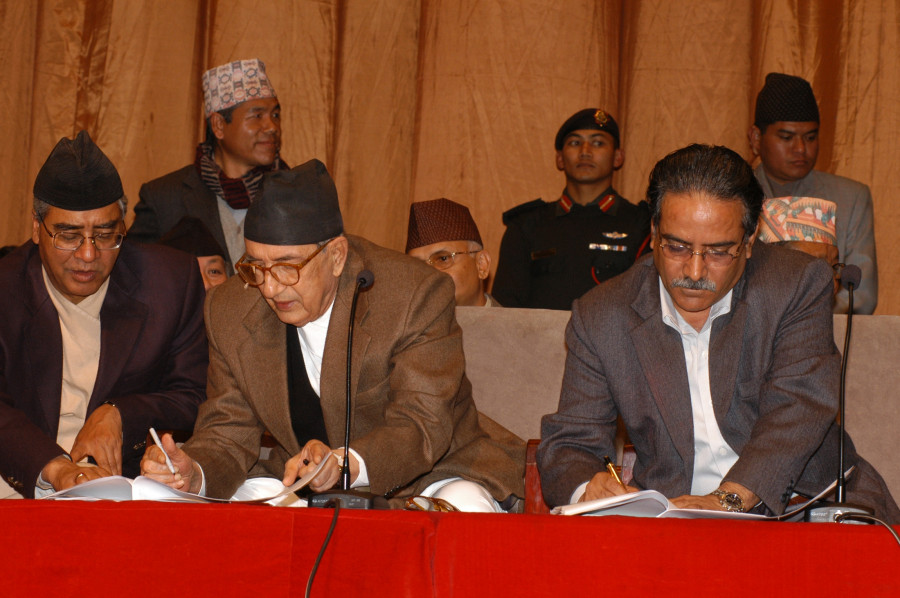Columns
Is it a peace process?
Though peace is an end in itself, it was also treated as a means in the war-torn Nepal.
Birendra P Mishra
In 1950, the Nepali Congress fought against the Rana oligarchic rule and successfully overthrew the regime. They established a de facto monarchy with an assurance to hold an election for a Constituent Assembly (CA) by forming a coalition government led by the then Rana Prime Minister Mohan Shamsher to complete the task.
In February 1997, the Maoist Party took up arms against the state during the premiership of Nepali Congress leader Sher Bahadur Deuba. Initially, the insurgency was treated as a law and order problem, and the government unsuccessfully used its police force to control it. In 2001, after the assassination of King Birendra and his family members, King Gyanendra assumed power. But with the condition of the kingdom deteriorating, the Girija Prasad Koirala government tried to deploy the army, which the king sanctioned. This led to the resignation of the prime minister and the bifurcation of the Nepali Congress. Later, Deuba dissolved the House of Representatives (HoR) and announced a date for fresh elections, which he could not hold. The king dismissed the government and took control of the kingdom himself.
The royal takeover set the stage for a dialogue between the political parties and the Maoists, as the parties were thrown out of power and the Maoists were under tremendous pressure. It turned the conflict bipolar from a tripolar one. They chose Indian towns in the adjoining border area for their primary negotiation. Finally, the Seven-Party Alliance and the Maoists decided to join hands and signed the 12-point understanding in Delhi on November 22, 2005.
The civil society leaders started the 2006 People’s Movement by breaking the prohibitory orders of the government at Bhotahiti and Maharajgunj. They were arrested, but their movement started spreading. Eventually, it forced the king to restore the parliament and form a new government. The Maoists announced a three-month ceasefire, and the government reciprocated it without any time frame. A Ceasefire Code of Conduct was framed, and a National Monitoring Committee was formed. Further, the Comprehensive Peace Accord was signed on November 21, 2006.
The restored HoR passed the Interim Constitution on January 15, 2007, which was approved by the newly constituted Interim Legislature consisting of members from the Maoists. This led to the formation of an interim government in May 2007, and the election of the first CA was held later in the same year. The United Mission in Nepal completed the verification of the Maoist combatants, and they were brought into the designated cantonments, and their arms and ammunition were placed under lock and key.
However, the CA failed to produce a constitution and was dissolved, and elections for the second CA were held. The new constitution was adopted on September 20, 2015, which declared Nepal a secular federal democratic republic. Since then, two parliamentary, provincial and local level elections have been held.
The events listed above suggest that the political aspirations of the parties, including the Maoists, have been fulfilled, as it provided the posts of vice-president, prime minister, home minister, finance minister, governor, etc., to them. They are running the government according to their will. However, the peace process has yet to conclude for want of appropriate laws and impartial operating machinery. Like the dead body of Nanda Prasad Adhikari in the morgue of the TU Teaching Hospital, waiting for its funeral rites for several years, demanding justice for his son’s killing by the insurgents, many other war victims are waiting for justice.
Since joining the interim government in 2007, the Maoists have been in power almost continuously. After a long time, the Truth and Reconciliation Commission and the Commission of Enquiry for Forced Disappearances were formed, but they could not fulfil their functions for want of appropriate power to deliver justice. The government has spent a lot of money as reparation, but money can only make up for the financial losses of the victims. The emotional wounds from the instances of killing and the rape are still fresh.
The CPA does provide for an investigation of truth (5.2.2), but there is no guarantee of justice for the victims. Sadly, the 12-point understanding is also silent regarding this issue.
The peace process turned into a power-acquiring process, as the attention of the leaders exclusively concentrated on acquiring power and not on the proper facilitation, monitoring and execution of agreements signed earlier. Had it been facilitated properly, such provisions as taking care of the serious crimes committed by culprits would have been incorporated in the CPA and related laws. Had it been monitored seriously, the government would have passed such legislation earlier for the victims' justice.
Though peace is an end in itself, parties treated it as a means in war-torn Nepal, and the incomplete peace process provides political power to the insurgents. Thus, the peace process in Nepal can be called the Peaceful Revolutionary Process on the following grounds: It turned Nepal from a monarchy to a Republic, proving that the end does not justify the means. It made violent Maoists a non-violent party. It also proved that ballots are more effective than bullets in acquiring power.




 11.12°C Kathmandu
11.12°C Kathmandu













%20(1).jpg&w=300&height=200)

